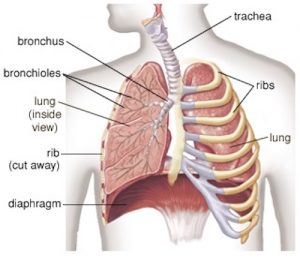I have been teaching for 14 years. Many times I get new students, both professional and beginner, with amazing talent. They come to me because they want to either learn or they’re having problems with certain songs and notes in their higher register. Most of the time, these problems are immediately fixed by teaching proper breathing techniques.
The Problem
Most of us have a problem called shallow breathing. Shallow breathing is expanding the rib cage, lifting our shoulders and taking a breath. Why do we do this? The problem is in the mind. The rib cage is flexible. Expanding it tells the mind that we have room for more air. This misconception leads us to use only 50% of lung capacity, which gives us little air to use for singing. When it’s time to sing a higher note or hold out longer notes, we fail. To avoid embarrassment, the brain engages improper muscles in the throat and we push the sound. This wears out the vocal cords, causing the cords to either swell or crack. Over time, this can lead to voice loss or permanent damage.
The Correct Way
Lay down on the bed or floor. Place your hand on your stomach, just above the belly button. Now breath. Notice anything different? The chest cavity doesn’t move, but the stomach does. This is called diaphramic breathing and it is an involuntary muscle process that happens when we sleep. Sleep is the activity in which the body heals itself. During sleep, we breathe this way, using 100% of the lung’s capacity. The taking in of oxygen during a rest heals the body throughout the night, enabling us to function properly for the next day.
The Diaphragm
The reason the stomach moves when we breathe is because of a thin muscle that runs underneath the lungs called the diaphragm. This muscle is like a thin, flat piece of rubber. If you were to stretch a thin, flat piece of rubber and let it go, it would return to the original shape. The diaphragm is no different. As it contracts, it pulls out, causing the stomach to expand. This creates a vacuum in which air is pulled into the lungs. When the diaphragm relaxes, like that thin piece of rubber, it returns to its original shape, forcing air out of the lungs. The singer must be able to breathe this way in order to have maximum vocal efficiency.
called the diaphragm. This muscle is like a thin, flat piece of rubber. If you were to stretch a thin, flat piece of rubber and let it go, it would return to the original shape. The diaphragm is no different. As it contracts, it pulls out, causing the stomach to expand. This creates a vacuum in which air is pulled into the lungs. When the diaphragm relaxes, like that thin piece of rubber, it returns to its original shape, forcing air out of the lungs. The singer must be able to breathe this way in order to have maximum vocal efficiency.
The Art of Proper Breathing
The obvious question is “how do I breathe this way standing up?” It takes a lot of practice. A singer must learn this technique and use it constantly when performing. A normal breathing process is a quick inhale and exhale. The singer must have a quick, deep inhale and slow, extended exhale to support an entire phrase or note as they sing. One method for ensuring a deep, diaphragmic breath is practicing with the lips puckered, like breathing through a straw. This will engage the diaphragm and will pull the air to the bottom of the lungs. For more control and a fuller sound, the singer pulls the diaphragm in as they sing, like pulling the belly button to the spine. This creates a strong force of air pressure which enables the singer to maintain strength and control throughout each register. It is the fuel behind every tone and phrase.
Try it out
If you are having vocal problems, improper breathing may be the culprit. Give it a shot and see how it goes. Beware! You will have more power and the voice may “splat” on you at first. Don’t worry! Just pull back on the normal energy you give a particular note or phrase. With diaphramic breathing, the voice will work way more efficiently so you don’t have to.
©2018 SeanyMac Studios, Sean Oliver All rights reserved.
